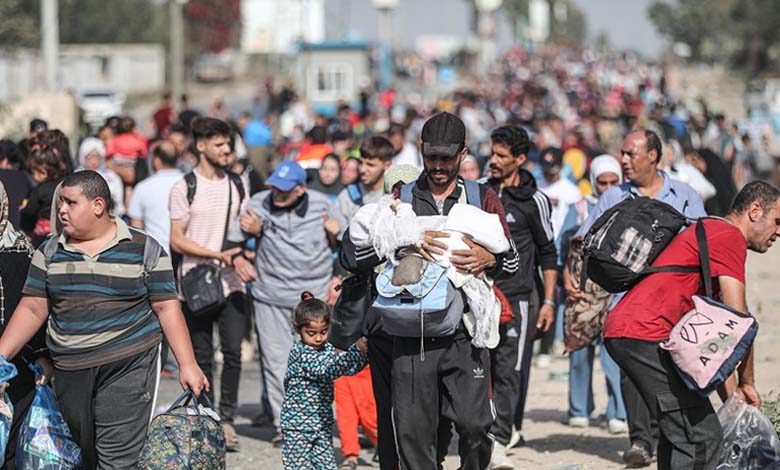CNN: New Israeli Evacuation Orders for Thousands of Palestinians in Gaza

Thousands of Palestinians are once again fleeing Gaza, as the Israeli army issues new evacuation orders for several areas in Gaza City. Over the past ten days, the Israeli occupation army has instructed hundreds of thousands of people in Khan Younis in the south, Shuja’iyya in central Gaza, and many neighborhoods of Gaza City to leave.
New Displacement
American network CNN confirmed an increase in the total number of displaced persons in Gaza, from 1.7 million in May to around 1.9 million now, according to the United Nations. Estimates now indicate that nearly nine out of ten people in Gaza have been displaced internally, many of them multiple times.
According to the latest assessment from the United Nations Office for the Coordination of Humanitarian Affairs (OCHA): “The main driver of this mass displacement has been evacuation orders issued by the Israeli army, widespread destruction of private and public infrastructure, restriction of access to basic services, and ongoing fear of continued hostile acts.”
The network added that it was unclear how many people in Gaza had responded to the latest evacuation orders, with many civilians reluctant to leave any shelter for an uncertain destination under circumstances where they live in the streets or in overcrowded and unhealthy tent villages with each evacuation order.
The Israeli army said that these evacuation orders were necessary to prevent civilians from becoming trapped in its ongoing operations to restore areas that Hamas seeks to reoccupy, asserting that it is doing its utmost to avoid civilian casualties.
Meanwhile, Hamas said that these evacuations threatened to reset negotiations on a ceasefire and prisoner exchange to square one.
Wide Evacuation Operations
Khader al-Zahhar, a journalist with the official Palestinian news agency (WAFA), said that late Sunday, instructions were issued for residents of Al-Tuffah, the Old City, and Al-Daraj neighborhoods to move to known shelters in western Gaza, but added, “The wide-scale evacuation came amid airstrikes and drones.”
He continued, “It was terrifying, people were running, some in wheelchairs, everyone was in a panic not knowing where to go, heavy shelling was close by and smoke filled the sky.”
But at dawn, airstrikes targeted a towering building near where he and his family and many other displaced people had sought refuge.
The Office for the Coordination of Humanitarian Affairs estimates that about 80,000 people were living in Shuja’iyya when the evacuation order was issued on June 27, while another 250,000 were living east of Khan Younis and Rafah under evacuation orders from Israeli authorities on July 1.
On that day, the Israeli army said that residents of 71 residential complexes east of Khan Younis and Rafah had to evacuate immediately to the west to what they call “the humanitarian zone” in the vicinity.
Hospitals Collapse
The Office for the Coordination of Humanitarian Affairs and other agencies said that evacuation orders had a major impact on the few operational hospitals in Gaza.
On July 2, Israeli authorities clarified that the European Hospital in Khan Younis was not included in the evacuation order, but that time had elapsed and most medical staff and patients had already left. A UN staff member, Jonathan Wittal, reported from the hospital, “There are no more patients, there is no equipment, it is no longer operational.”
World Health Organization Director-General Tedros Adhanom Ghebreyesus said on Channel X, “It is devastating to see a hospital with a capacity of over 650 beds out of service when the need for healthcare is urgent.”
Also, the International Committee of the Red Cross team, which has performed more than 3,000 surgical operations since the beginning of the conflict, also left the hospital.
Many evacuees from the European Hospital gathered at nearby Nasser Medical Complex, which reached its full capacity.
-
Leads to Agreement Ending Gaza War… Hamas “Abandons” Condition Hindering Negotiations
-
The Israeli Dilemma… Who Governs Gaza After the War?
The World Health Organization and other agencies managed to transfer much equipment from the European Hospital to Nasser Hospital, including ventilators and anesthesia machines. But medical staff still wondered whether they should move again and when.
The American network added that another major hospital in Gaza, Al-Ahli Al-Muqaddas Hospital, had also closed its doors, and the Episcopal Church of Jerusalem, which manages the hospital, said that following several drone attacks in the neighboring area on Sunday, the hospital was placed in the “red zone” for evacuation.












